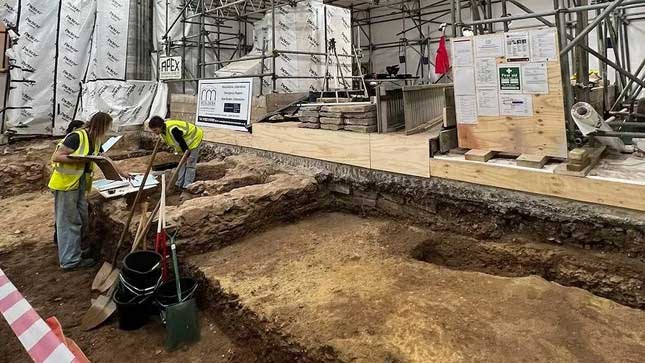Archaeologists in England have uncovered a high altar from the 12th century, a medieval tomb, and the empty graves of two bishops during the excavation of Exeter Cathedral.
The cathedral, built around 1400 AD, occupies the same site as the original building from 1114, when it was constructed in the Norman architectural style.

After removing part of the church floor, workers discovered hidden sections of the original cathedral. (Photo: Exeter Cathedral).
Although the two towers of the original structure now stand adjacent as part of the existing wall, the remainder of the Anglican cathedral was rebuilt between 1270 and 1350 AD in a Gothic style, according to Smithsonian Magazine.
The excavations are part of an ongoing construction project to install underfloor heating. Initially, they uncovered the altar, where the priest stood to preach. After workers removed the flooring, a section of the cathedral where clergy and the choir sat during religious services was revealed. This may be the buried floors of the original cathedral from 900 years ago and beyond, according to BBC News.
John Allan, the cathedral’s archaeologist and an honorary fellow at the University of Exeter, told BBC News: “Behind the altar, to the east, is an area that has been remarkably filled with earth, which we believe must certainly be a Norman tomb. This is undoubtedly the most exciting archaeological discovery ever made at Exeter Cathedral.”
According to a statement, the underground tomb was filled in around 1300 AD, a discovery that contradicts the long-held belief that the cathedral never had a tomb.
The removal of the earth covering the tomb revealed a series of empty graves that likely belonged to two bishops: Robert Warelwast (nephew of William Warelwast, the founding bishop who died around 1155 AD) and William Brewer (who died in 1244 AD). However, these tombs are empty as they were relocated in the 1300s.
In a previous excavation in March, archaeologists uncovered an early Roman road, wooden buildings, and the wall of a Roman house buried in the cathedral’s monastery garden, reported BBC News at the time.
The cathedral is still used by worshippers today as an Anglican church.


















































